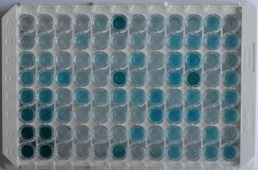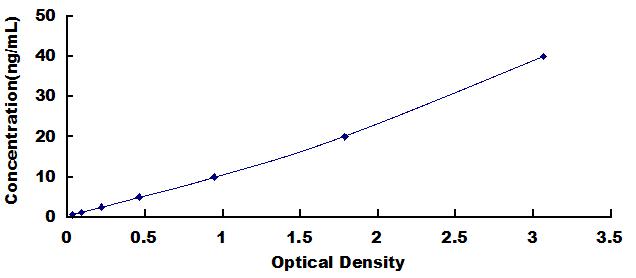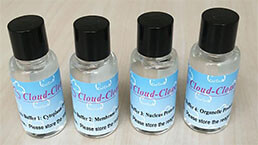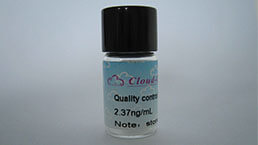Packages (Simulation)

Reagent Preparation

Image (I)
Image (II)
Certificate


High Sensitive ELISA Kit for Syndecan 1 (SDC1)
CD138; SDC; SYND1; Syndecan Proteoglycan 1
- Product No.HEB966Hu
- Organism SpeciesHomo sapiens (Human) Same name, Different species.
- Sample Typeserum, plasma, tissue homogenates, cell lysates, cell culture supernates and other biological fluids
- Test MethodDouble-antibody Sandwich
- Assay Length3h
- Detection Range0.625-40ng/mL
- SensitivityThe minimum detectable dose of this kit is typically less than 0.283ng/mL.
- DownloadInstruction Manual
- UOM 48T96T 96T*5 96T*10 96T*100
- FOB
US$ 512
US$ 732
US$ 3294
US$ 6222
US$ 51240
For more details, please contact local distributors!
Specificity
This assay has high sensitivity and excellent specificity for detection of High Sensitive Syndecan 1 (SDC1).
No significant cross-reactivity or interference between High Sensitive Syndecan 1 (SDC1) and analogues was observed.
Recovery
Matrices listed below were spiked with certain level of recombinant High Sensitive Syndecan 1 (SDC1) and the recovery rates were calculated by comparing the measured value to the expected amount of High Sensitive Syndecan 1 (SDC1) in samples.
| Matrix | Recovery range (%) | Average(%) |
| serum(n=5) | 84-98 | 91 |
| EDTA plasma(n=5) | 89-101 | 94 |
| heparin plasma(n=5) | 83-92 | 87 |
Precision
Intra-assay Precision (Precision within an assay): 3 samples with low, middle and high level High Sensitive Syndecan 1 (SDC1) were tested 20 times on one plate, respectively.
Inter-assay Precision (Precision between assays): 3 samples with low, middle and high level High Sensitive Syndecan 1 (SDC1) were tested on 3 different plates, 8 replicates in each plate.
CV(%) = SD/meanX100
Intra-Assay: CV<10%
Inter-Assay: CV<12%
Linearity
The linearity of the kit was assayed by testing samples spiked with appropriate concentration of High Sensitive Syndecan 1 (SDC1) and their serial dilutions. The results were demonstrated by the percentage of calculated concentration to the expected.
| Sample | 1:2 | 1:4 | 1:8 | 1:16 |
| serum(n=5) | 80-99% | 79-94% | 79-99% | 93-102% |
| EDTA plasma(n=5) | 87-101% | 95-103% | 78-101% | 96-103% |
| heparin plasma(n=5) | 94-105% | 80-96% | 89-98% | 87-95% |
Stability
The stability of kit is determined by the loss rate of activity. The loss rate of this kit is less than 5% within the expiration date under appropriate storage condition.
To minimize extra influence on the performance, operation procedures and lab conditions, especially room temperature, air humidity, incubator temperature should be strictly controlled. It is also strongly suggested that the whole assay is performed by the same operator from the beginning to the end.
Reagents and materials provided
| Reagents | Quantity | Reagents | Quantity |
| Pre-coated, ready to use 96-well strip plate | 1 | Plate sealer for 96 wells | 4 |
| Standard | 2 | Standard Diluent | 1×20mL |
| Detection Reagent A | 1×120µL | Assay Diluent A | 1×12mL |
| Detection Reagent B | 1×120µL | Assay Diluent B | 1×12mL |
| TMB Substrate | 1×9mL | Stop Solution | 1×6mL |
| Wash Buffer (30 × concentrate) | 1×20mL | Instruction manual | 1 |
Assay procedure summary
1. Prepare all reagents, samples and standards;
2. Add 100µL standard or sample to each well. Incubate 1 hours at 37°C;
3. Aspirate and add 100µL prepared Detection Reagent A. Incubate 1 hour at 37°C;
4. Aspirate and wash 3 times;
5. Add 100µL prepared Detection Reagent B. Incubate 30 minutes at 37°C;
6. Aspirate and wash 5 times;
7. Add 90µL Substrate Solution. Incubate 10-20 minutes at 37°C;
8. Add 50µL Stop Solution. Read at 450nm immediately.
GIVEAWAYS
INCREMENT SERVICES
| Magazine | Citations |
| Molecular and Cellular Biochemistry | Increased level of soluble syndecan-1 in serum correlates with myocardial expression in a rat model of myocardial infarction SpringerLink: a201w3l18k257462 |
| Inflammation | Sdc1 Overexpression Inhibits the p38 MAPK Pathway and Lessens Fibrotic Ventricular Remodeling in MI Rats Springer: Source |
| Atherosclerosis. | Damage of the endothelial glycocalyx in chronic kidney disease Pubmed:24727235 |
| Journal of Trauma and Acute Care Surgery | Effect of valproic acid and injury on lesion size and endothelial glycocalyx shedding in a rodent model of isolated traumatic brain injury Pubmed:25058256 |
| Shock | Impairment of the Endothelial Glycocalyx in Cardiogenic Shock and its Prognostic Relevance Pubmed:25692257 |
| Mediators Inflamm | Dexamethasone Suppressed LPS-Induced Matrix Metalloproteinase and Its Effect on Endothelial Glycocalyx Shedding PubMed: 26199464 |
| Transplantation | Platelet-Derived Growth Factor-B Protects Rat Cardiac Allografts From Ischemia-reperfusion Injury. PubMed: 26371596 |
| Clinical and Experimental Nephrology | Dual antiplatelet and anticoagulant APAC prevents experimental ischemia–reperfusion-induced acute kidney injury pubmed:27405618 |
| Biomarkers in Medicine | Endothelial glycocalyx layer shedding following lung resection pubmed:27643669 |
| Danish National RESEARCH DATABASE | Resuscitation with Pooled and Pathogen-Reduced Plasma Attenuates the Increase in Brain Water Content following Traumatic Brain Injury and Hemorrhagic Shock in Rats 10.1089 |
| Journal of Neurotrauma | Resuscitation with pooled and pathogen-reduced plasma attenuates the increase in brain water content following traumatic brain injury and hemorrhagic shock in rats the rat. doi/10.1089/neu.2016.4574 |
| British Journal of Anaesthesia | Volume kinetics of Ringer's lactate solution in acute inflammatory disease 10.1016:j.bja.2018.04.023 |
| Arteriosclerosis, Thrombosis, and Vascular Biology | MPO (myeloperoxidase) reduces endothelial glycocalyx thickness dependent on its cationic charge Pubmed:29903730 |
| Shock | Plasma resuscitation improved survival in a cecal ligation and puncture rat model of sepsis Pubmed:28591008 |
| Shock | Experimental models of endotheliopathy: impact of shock severity Pubmed:28697004 |
| Journal of Trauma and Acute Care Surgery | Effects of propranolol and clonidine on brain edema, blood-brain barrier permeability, and endothelial glycocalyx disruption after fluid percussion brain injury in the rat Pubmed:28930945 |
| The Endothelial Glycocalyx in the Peritoneal Microcirculation of Rats with Chronic Kidney Failure Exposed to Dialysis Solutions 173015_06.pdf | |
| Journal of Surgical Research | Plasma ameliorates endothelial dysfunction in burn injury Doi: 10.1016/j.jss.2018.08.027 |
| Journal of Anesthesia | Dexmedetomidine preserves the endothelial glycocalyx and improves survival in a rat heatstroke model Pubmed: 30374889 |
| Anaesthesia | Postoperative microcirculatory perfusion and endothelial glycocalyx shedding following cardiac surgery with cardiopulmonary bypass Pubmed: 30687934 |
| Journal of Cardiothoracic and Vascular Anesthesial | Microvascular alterations during cardiac surgery using a heparin or phosphorylcholine coated circuit Pubmed: 31787433 |
| Hepatobiliary & Pancreatic Diseases International | Increased syndecan-1 and glypican-3 predict poor perinatal outcome and treatment resistance in intrahepatic cholestasis: Syndecan-1, glypican-3 and ICP Pubmed: 31919038 |
| Heparin Binding Protein and Endothelial Glycocalyx Markers in Severe COVID-19–A Prospective Observational Cohort Study | |
| INTERNATIONAL JOURNAL OF MOLECULAR SCIENCES | Newly Developed Recombinant Antithrombin Protects the Endothelial Glycocalyx in an Endotoxin-Induced Rat Model of Sepsis 33375342 |
| Microvasc Res | Effect of liraglutide on microcirculation in rat model with absolute insulin deficiency 34119534 |
| J Gerontol A Biol Sci Med Sci | The effect of pre-operative methylprednisolone on postoperative delirium in elderly patients undergoing gastrointestinal surgery: a randomized, double-blind, placebo … 34423832 |
| Shock | Inhalation of 2% hydrogen improves survival rate and attenuates shedding of vascular endothelial glycocalyx in rats with heat stroke 34524269 |
| Exp Anim | Dexmedetomidine suppresses serum syndecan-1 elevation and improves survival in a rat hemorrhagic shock model Pubmed:35110424 |
| Journal of Emergency Medicine | Resuscitation of hemorrhagic shock using normal saline does not damage the glycocalyx in the immediate resuscitation phase |
| Catalog No. | Related products for research use of Homo sapiens (Human) Organism species | Applications (RESEARCH USE ONLY!) |
| EPB966Hu62 | Eukaryotic Syndecan 1 (SDC1) | Positive Control; Immunogen; SDS-PAGE; WB. |
| RPB966Hu01 | Recombinant Syndecan 1 (SDC1) | Positive Control; Immunogen; SDS-PAGE; WB. |
| EPB966Hu61 | Eukaryotic Syndecan 1 (SDC1) | Positive Control; Immunogen; SDS-PAGE; WB. |
| RPB966Hu02 | Recombinant Syndecan 1 (SDC1) | Positive Control; Immunogen; SDS-PAGE; WB. |
| RPB966Hu03 | Recombinant Syndecan 1 (SDC1) | Positive Control; Immunogen; SDS-PAGE; WB. |
| PAB966Hu01 | Polyclonal Antibody to Syndecan 1 (SDC1) | WB; IHC; ICC/IF |
| FAB966Hu01 | Anti-Syndecan 1 (SDC1) Polyclonal Antibody | Flow cytometry. |
| FAB966Hu41 | PE-Linked Anti-Syndecan 1 (SDC1) Polyclonal Antibody | Flow cytometry. |
| FAB966Hu51 | APC-Linked Anti-Syndecan 1 (SDC1) Polyclonal Antibody | Flow cytometry. |
| FAB966Hu81 | FITC-Linked Anti-Syndecan 1 (SDC1) Polyclonal Antibody | FCM |
| MAB966Hu21 | Monoclonal Antibody to Syndecan 1 (SDC1) | WB; IHC |
| MAB966Hu23 | Monoclonal Antibody to Syndecan 1 (SDC1) | WB |
| MAB966Hu22 | Monoclonal Antibody to Syndecan 1 (SDC1) | WB |
| MAB966Hu24 | Monoclonal Antibody to Syndecan 1 (SDC1) | WB |
| MAB966Hu25 | Monoclonal Antibody to Syndecan 1 (SDC1) | WB |
| RAB966Hu21 | Recombinant Antibody to Syndecan 1 (SDC1) | WB; IF; ICC; IHC; IP; FCM. |
| MAB966Hu27 | Monoclonal Antibody to Syndecan 1 (SDC1) | IHC |
| MAB966Hu29 | Monoclonal Antibody to Syndecan 1 (SDC1) | WB; IHC; ICC/IF |
| SEB966Hu | ELISA Kit for Syndecan 1 (SDC1) | Enzyme-linked immunosorbent assay for Antigen Detection. |
| HEB966Hu | High Sensitive ELISA Kit for Syndecan 1 (SDC1) | Enzyme-linked immunosorbent assay for Antigen Detection. |
| LMB966Hu | Multiplex Assay Kit for Syndecan 1 (SDC1) ,etc. by FLIA (Flow Luminescence Immunoassay) | FLIA Kit for Antigen Detection. |
| KSB966Hu01 | ELISA Kit DIY Materials for Syndecan 1 (SDC1) | Main materials for "Do It (ELISA Kit) Yourself". |













